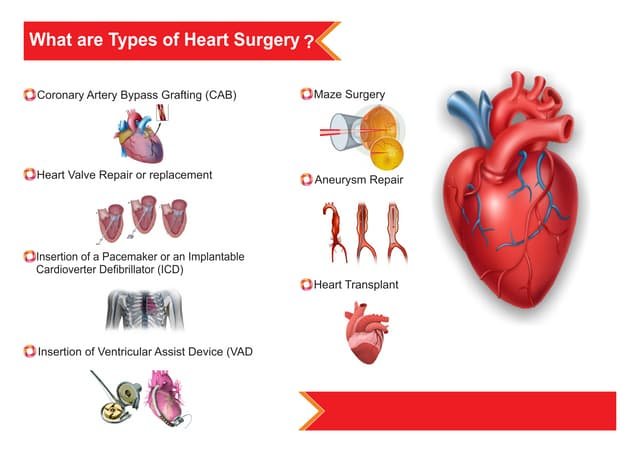There are various kinds of heart problems, but not every type of cardiac disease always requires Heart Surgery. Sometimes the doctors recommend other methods such as lifestyle changes, medications or other nonsurgical procedures. But often, to treat problems like heart failure, or a plaque buildup in the arteries (blockage), surgeries can be the life-saving treatment.
What are the types of heart surgery?
Different types of heart surgeries are available nowadays, depending on the requirement (disease to be treated) and the technique used. Some heart surgeries are mentioned below:
- Coronary artery bypass grafting (CABG) – Also known as heart bypass or coronary artery bypass surgery. This is the most common type of heart surgery performed. The surgeon takes a healthy artery/vein from other parts of the body and uses it to connect the blood vessel past the blocked artery to restore the blood flow. This grafted vein/artery is basically used to bypass the blocked portion of the coronary artery, thereby creating a new path for blood to flow to the heart muscles. Sometimes, it can be done for more than one blocked artery during the same surgery. CABG surgery cost in India ranges between 13000 USD to 17000 USD.
- Heart valve repair/replacement – In this surgery, the heart valve is either repaired or is replaced with an artificial valve to correct the defect. The artificial valve can be made from biological sources such as from a pig, cow or human heart tissue or it can be mechanical with metal parts. In a catheter-based procedure, the surgeon inserts a catheter into the large blood vessel, guides it to the heart and then inflates and deflates a small balloon at the tip of the catheter to widen the narrow valve.
- Implantable cardioverter-defibrillator (ICD) – This is a method of treatment for patients with arrhythmia, a condition in which the heart has an irregular heart rhythm In these cases, ICD placement is recommended when medications don’t work. The surgeon places a pacemaker under the skin of the chest/abdomen, with wires connecting to the heart chamber. This device controls the heart rhythm with electrical pulses and a sensor that detects any dangerous arrhythmias.
- Maze surgery – In this surgery, a pattern of scar tissue is created in the upper chambers of the heart to redirect signals along a controlled path to the lower heart chambers. This surgery blocks the abnormal electrical signals which cause atrial fibrillation – the most serious type of arrhythmia.
- Aneurysm repair – An aortic aneurysm is a bulge in the wall of the main blood vessel (aorta) which carries blood from the heart to the rest of the body. The surgery for its repair involves the use of a balloon-like instrument, which does the surgical repair to stop the bleeding.
- Heart Transplant – It is one of the most advanced surgical procedures. In this surgery, the heart of a diseased patient is replaced with a healthy donor heart. A heart transplant is one of the last resorts for heart failure and is recommended when all the other options including medications and surgeries have failed to improve the condition. It is sometimes a part of a multi-organ transplant – which can be heart-kidney, heart-liver, or heart-lung. It is major surgery, and the primary complications involve the rejection of the donor’s heart.
- Placement of a ventricular assist device (VAD) or Total artificial heart (TAH) – A VAD is a medical device that mechanically pumps the blood and performs heart function to maintain proper blood flow. VADs are usually used as temporary measures for people who are in the list of awaiting heart transplants. In cases a VAD fails, the doctors recommend for a TAH, to replace the two lower chambers of the heart.
In addition to these, a popular minimally invasive procedure is done called transcatheter structural heart surgery. This surgery involves the use of a long, thin, flexible tube that is guided through a blood vessel to the heart. The aim is to implant an artificial aortic valve to replace the damaged valve.
Risks involved in heart surgeries –
- Bleeding
- Infection
- Reaction to anesthesia
- Damage to tissues in the heart, kidney, liver or lungs
- Stroke
- Death, in rare cases
The risk of the complications increases if the patients have certain comorbidities, such as diabetes, hypertension and so on.
What to expect after heart surgery?
For the first couple of days, the patients remain in an intensive care unit (ICU), where they receive medications and regular tests to monitor the progress. Some patients may require oxygen support to aid in breathing.
After getting discharged, the patients are advised –
- Care for the incisions, prevent them from getting infected
- Recognize the signs of infections, or other complications
- Cope with the after-effects of the surgery
Some common after-effects of heart surgery are expected normal, which might include – muscle pain, chest pain, shortness of breath, or swelling in the leg (especially in cases for CABG, where a leg incision was put).
Other side effects might include – loss of appetite, problems in sleeping, constipation and mood swings.
Some people might also experience memory loss and problems concentrating. These side effects go away over time, but if the patient experience any worsening of the above-mentioned symptoms, they should visit their cardiologist for a follow-up.
Medications that are prescribed for pain relief can be –
- Nerve Blockers
- Non Steroidal Anti-inflammatory Drugs (NSAIDs)
- Acetaminophen
- Ketamine
In most of cases, the pain is not long-standing. By the time the patient is discharged, the pain management is rather easy.










